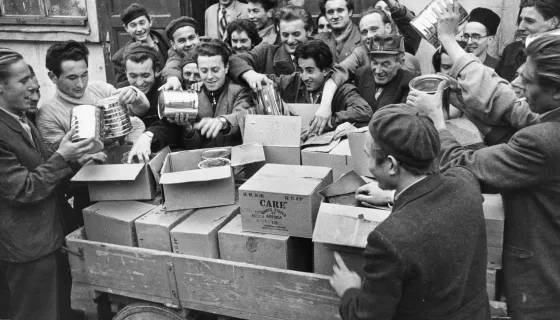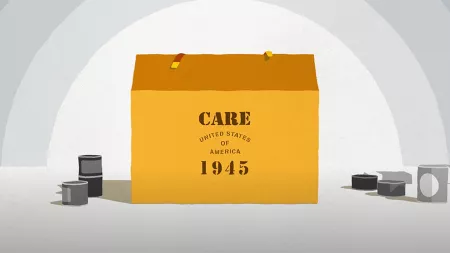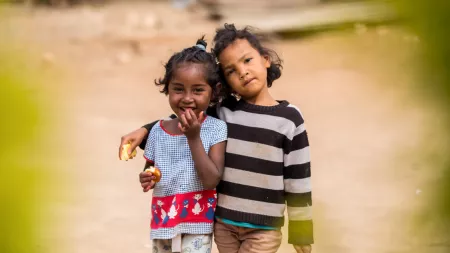

CARE International has been working to provide lasting solutions to poverty and responding to disasters and emergencies since the 1940s.
CARE International is one of the largest poverty-fighting organizations in the world, providing relief to people hit by emergencies, and contributing to economic empowerment that strengthens livelihoods over the long term.
What is now a wide network of partners working globally to tackle social injustice started with a simple emergency relief package, delivered over seven decades ago.
The first CARE Package™ arrived in Le Havre, France, in May 1946, the first of a wave of responses to millions of people in need of food and relief supplies at the end of World War II. Known then as the Cooperative for American Remittances to Europe, it consisted of 22 American charities of civic, religious, cooperative, and labor backgrounds.
CARE took possession of 2.8 million USA army surplus packages in 1946, each containing enough food to feed 10 people for one day, or one person for 10 days. The packages contained staples such as butter, dried milk, canned meat, and sometimes even chocolate and chewing gum.

With Europe on the road to recovery, CARE found itself increasingly involved in Asia – first in Japan and then in the Philippines, Korea, India, and Pakistan. By the early 1950s, operations had been established in a number of Latin American countries, followed by Africa in the early 1960s. CARE at this time also began providing medical services as well as assistance to people in war-torn areas.
In most places around the world where humanitarian relief was required, CARE had workers on the ground. In recognition of its broadened service offerings and geographic scope, CARE changed its name in 1953 to the Cooperative for American Relief Everywhere.
Throughout the 1960s and 1970s, CARE expanded its remit beyond immediate and short-term relief to more long-term assistance in the form of recovery and rehabilitation. With the Peace Corps established in 1961, CARE began to train volunteers and help manage the Peace Corp’s first projects. We continued to respond with food distribution in the wake of disasters and emergencies but also initiated innovative projects to help communities better provide for themselves.
CARE opened an office in Canada in 1946, yet it was not until the mid-1970s that the organization truly started to become an international body. CARE Canada (initially Care of Canada) became an autonomous body in 1973. In 1976 CARE Europe was established in Bonn following the successful fundraising campaign "Dank an CARE" (Thanks to CARE). In 1981 CARE Germany was created and CARE Europe moved its headquarters to Paris.
CARE Norway followed in 1980, when CAREs in Italy and the UK were also established. The popularity of CARE offices in Europe was attributed to the fact that many Europeans remembered receiving CARE assistance themselves between 1945 and 1955.
In 1979 planning began for the establishment of an umbrella organization to coordinate and prevent duplication among the various national CARE organizations. This new body was named CARE International and met for the first time on January 29, 1982, with CARE Canada, CARE Germany, CARE Norway, and CARE USA in attendance.
CARE International would expand significantly during the 1980s, with the addition of CARE France in 1983; CARE International UK in 1985; CARE Austria in 1986; and CARE Australia, CARE Denmark, and CARE Japan in 1987.
Gender equality is key to overcoming global poverty. Empowered women and girls improve not only their individual life conditions but also that of the communities around them. In the early 1980s, our longer-term development programs increasingly began focusing on ways to improve the status of women and girls and encourage their greater participation.
When women earn, everyone benefits. This was CARE’s guiding vision when we launched our first Village Savings and Loan Association in Niger in 1991, still today one of our flagship programs for women economic empowerment. By harnessing the ancient African practice of group savings, in which community members pool their resources to create a kind of village bank. The method provides an effective strategy for women to save small amounts, see their collective savings grow, and borrow money in times of hardship, such as droughts or illness, or to invest in setting up a small business.
From the civil war in Rwanda to the Persian Gulf War, CARE International was there providing relief in increasingly dangerous operational environments.
In 1993, to reflect the wider scope of our programs and impact, CARE changed the meaning of its acronym to Cooperative for Assistance and Relief Everywhere.

We help women and girls empower themselves to overcome poverty, focusing on education, economic empowerment, and promoting their voices.